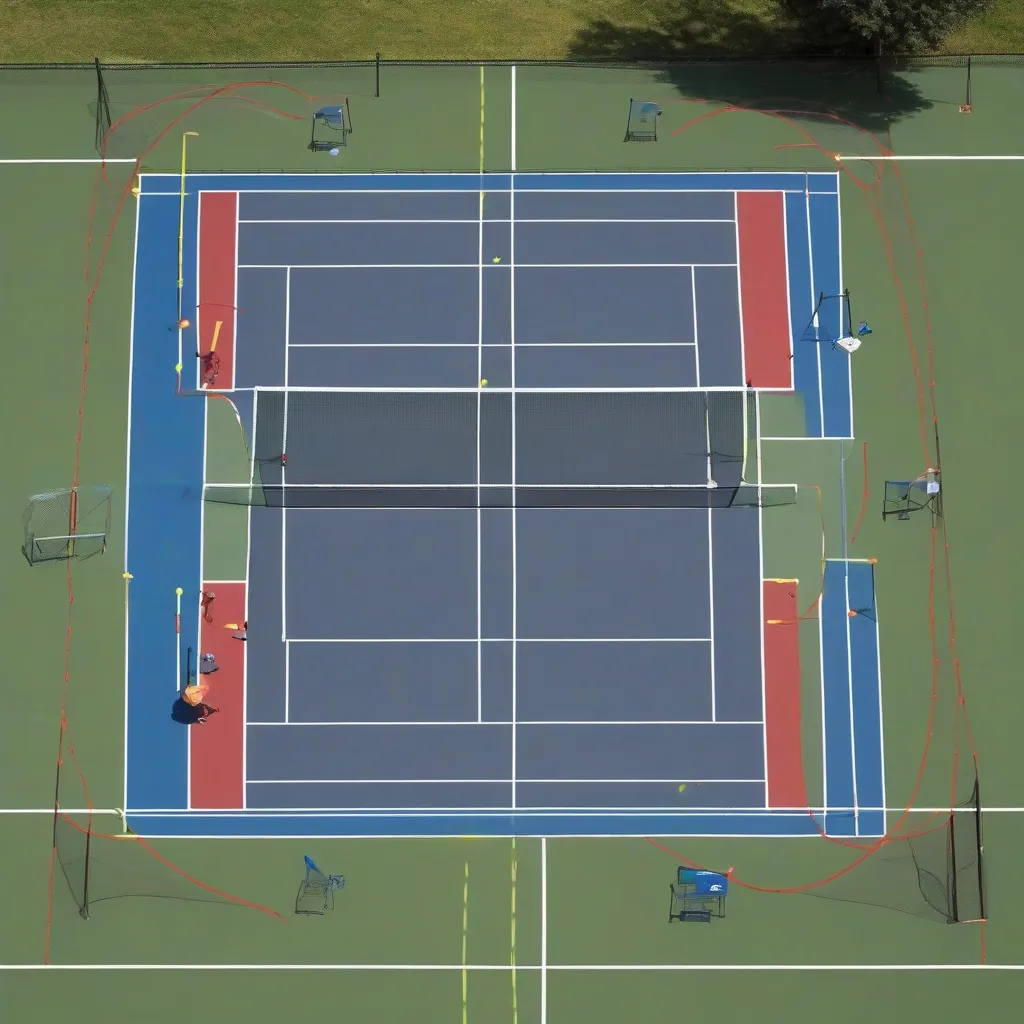Table of Contents
Pickleball Court Setup: Introduction to a Successful Court
Setting up a pickleball court correctly is essential for ensuring a great playing experience. Whether you’re setting up a temporary court in your driveway or a permanent court in a dedicated facility, following the right steps and guidelines will help you create a functional and enjoyable court. This guide covers everything you need to know about pickleball court setup, from dimensions to essential equipment.
Why Proper Court Setup is Important in Pickleball
Proper court setup in pickleball provides several benefits, including:
- Optimal Playability: Ensures the court meets standard dimensions and provides a fair playing surface.
- Safety: Reduces the risk of injuries by providing a well-marked and obstacle-free playing area.
- Enhanced Experience: Improves the overall enjoyment and quality of the game.
- Compliance: Meets official rules and regulations for tournaments and league play.
Step-by-Step Guide to Pickleball Court Setup
1. Choose the Location
Select a flat, level surface for your court. Popular options include driveways, gym floors, tennis courts, and dedicated pickleball courts. Ensure the area is free from obstacles and provides enough space around the court for movement.
 Standard Pickleball Court
Standard Pickleball Court
2. Measure and Mark the Dimensions
Official pickleball court dimensions are 20 feet wide and 44 feet long. Use measuring tape and chalk or tape to mark the boundaries. Ensure the lines are straight and the corners form right angles.
3. Mark the Non-Volley Zone (Kitchen)
Measure 7 feet from the net on both sides and mark the non-volley zone. This area is crucial for maintaining fair play and preventing volleying close to the net.
4. Set Up the Net
Position the net in the center of the court. The net should be 22 feet long and 36 inches high at the sidelines, and 34 inches high in the center. Ensure the net is taut and properly secured.
5. Add Boundary Lines
Use tape or paint to mark the boundary lines clearly. These lines include the baseline, sidelines, and the centerline dividing the service courts. Make sure the lines are 2 inches wide and clearly visible.
6. Equip the Court
7. Conduct a Safety Check
Inspect the court for any hazards or obstacles. Ensure the surface is clean and free of debris. Check the net for proper tension and alignment. Make sure all boundary lines are clearly visible.
8. Test the Court
Tips for Maintaining Your Pickleball Court
Proper maintenance of your pickleball court is essential for ensuring a consistent playing experience and prolonging the court’s lifespan. Here are some tips for maintaining your court:
1. Regular Cleaning
Keep the court surface clean by sweeping or blowing away debris regularly. Clean the court with water and mild detergent as needed to remove dirt and stains.
2. Inspect the Net
Check the net regularly for wear and tear. Ensure it remains taut and at the correct height. Replace the net if it becomes damaged or saggy.
3. Repaint Lines
Over time, the boundary lines may fade. Repaint the lines periodically to ensure they remain clearly visible. Use high-quality, weather-resistant paint for outdoor courts.
4. Check for Damage
Inspect the court surface for cracks, holes, or other damage. Repair any issues promptly to prevent further deterioration and ensure player safety.
5. Control Vegetation
For outdoor courts, keep the surrounding area free from overgrown vegetation. Trim grass and bushes regularly to prevent encroachment on the court.
Common Mistakes to Avoid in Court Setup
Avoid these common mistakes to ensure an effective and enjoyable court setup:
1. Incorrect Dimensions
2. Poor Net Setup
Make sure the net is at the correct height and properly secured. A sagging or misaligned net can affect the quality of play.
3. Faded Lines
Regularly repaint boundary lines to keep them visible. Faded lines can cause disputes and impact the accuracy of play.
4. Ignoring Safety
Conduct regular safety checks to ensure the court is free of hazards. Neglecting safety can lead to injuries and disrupt play.
5. Inadequate Space
Resources for Further Learning
For more detailed information on pickleball court setup and improving your game, explore these valuable resources:
- Visit the USA Pickleball Association (USAPA) for comprehensive guides and official rules.
- Explore instructional videos and articles on Pickleball Central.
- Check out detailed reviews and tutorials on Pickleball Portal.
- Learn from top players and coaches on PickleballMAX.
Conclusion
Setting up a pickleball court correctly is essential for ensuring a great playing experience. By following the step-by-step guide and incorporating the tips outlined in this article, you can create a functional and enjoyable court for yourself and others. Use these strategies to ensure your court is well-maintained, safe, and compliant with official regulations, enhancing your overall pickleball experience.
Frequently Asked Questions
- Why is proper court setup important in pickleball? Proper court setup ensures optimal playability, safety, enhanced experience, and compliance with official regulations.
- What are the standard dimensions for a pickleball court? The standard dimensions are 20 feet wide and 44 feet long.
- How high should the net be in the center and at the sidelines? The net should be 36 inches high at the sidelines and 34 inches high in the center.
- What equipment is needed for a pickleball court setup? Essential equipment includes a net, paddles, balls, boundary markers, and optional items like wind screens and scoreboards.
- Where can I find more information on pickleball court setup? Explore resources like the USA Pickleball Association, Pickleball Central, Pickleball Portal, and PickleballMAX for comprehensive guides and tutorials.